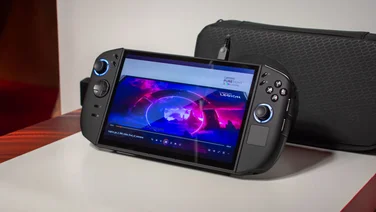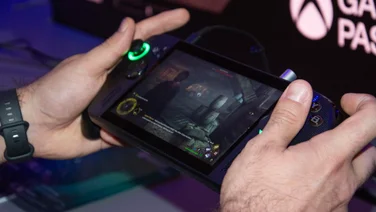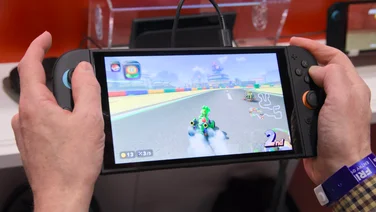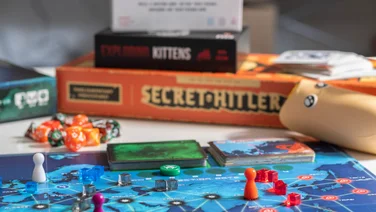To help us provide you with free impartial advice, we may earn a commission if you buy through links on our site. Learn more

































- Bigger, sharper and smoother display
- Plays 4K/60fps on compatible TVs
- Gameshare has great potential
- Big price increase
- Weaker battery life
- Game prices are getting ridiculous
Following up on a console that so effectively changed the game was always going to be a difficult task, but the Nintendo Switch 2 manages to surpass the original Nintendo Switch in nearly every key way. Performance is much better, the display is larger, sharper and has a higher refresh rate, the feature set is expanded and, finally, dock mode allows you to play games in 4K at 60fps.
You have to pay more for the privilege, and that big, vibrant display is something of a battery guzzler, but even with those issues in mind, the Switch 2 is a broadly excellent upgrade. It’s the biggest, fastest and most versatile Switch console yet, and one of the most uniquely compelling handheld consoles around right now.
Nintendo Switch 2 review: What you need to know
Eight years between drinks is quite a long time, so we have several big changes to discuss. First of all, the Switch 2 has the largest display on a Switch yet, now measuring 7.9in across the diagonal, and the dated 720p resolution has finally been upped to 1080p. We’ve also got HDR and VRR support (up to 120Hz) and ALLM (auto low-latency mode) for compatible TVs. Speaking of which, slide the Switch 2 into the provided dock and it can output a video signal to your TV at 4K/60Hz, 1080p at 120Hz or 1440p at the same.

































The new Joy-Con 2 controllers no longer slide into the edges of the display, instead snapping into grooves magnetically, where they’re held firmly in place by a strong latch. These hold their grip impressively well, only coming loose when you depress a small button, tucked just behind each trigger.
Elsewhere, the new C button, positioned low-down on the right Joy-Con enables a quick-launch of the GameChat voice chat feature, while both controllers have optical sensors on the connector edge, allowing you to use them like a computer mouse, for more granular control of games. That’s particularly useful for point-and-clicks, first-person shooters and real-time strategy games.
You need to snap the provided skates onto the Joy-Cons for the best mouse operation (once again, these clip on magnetically and are detached with that quick release button), and they’ve wrist straps come preattached. This can get in the way a little when you’re using the controller as a mouse but I still prefer this over having to juggle two different attachments.

































The most fundamental upgrade, however, comes inside, where the Switch runs on a new custom NVIDIA chipset. Nintendo is being traditionally cagey about specifics, so we can’t be 100% sure, but the leaks and rumours all agree that it’s an NVIDIA T239 SoC (system on chip) with an octa-core ARM Cortex A78C CPU and an Ampere GPU with 1,536 CUDA processing cores – six times as many as the Switch OLED.
Nintendo claims a peak clock speed of 1.7GHz for the CPU but reputable sources suggest that the Switch 2 will operate at lower speeds (1,101MHz handheld and 998MHz docked), at least for the time being. Similarly, those same sources state that the GPU is expected to hit 1,007MHz when docked and 561MHz in handheld mode.
Backing up the CPU and GPU is 12GB of LPDDR5X RAM across two 6GB modules – a massive improvement over the 4GB offered by previous models and it’s suggested that the memory bandwidth is higher, too.
Internal storage has been bumped up from 64GB to 256GB and, as before, the storage is expandable. This time, however, you can’t just use any old SD card as the system is restricted to microSD Express cards, which are considerably more expensive. On the bright side, the capacity supported runs to a massive 2TB, so you’ll have plenty of room for your game library.

































But while most of the hardware brings a net positive benefit, the larger battery is a 5,220mAh Li-Ion cell doesn’t mitigate the impact of its more power-hungry components. Nintendo says you can expect between 2 hours and 6hrs 30mins of battery life, compared to 4hrs 30mins and 9 hours of the original Switch and Switch OLED.
To test this out, I played Mario Kart World in handheld mode, at full brightness with HDR and 120Hz enabled, Wi-Fi connected and a pair of Bluetooth earbuds hooked up, playing audio at full volume – basically pushing it to the absolute limits. After an hour, the previously fully charged battery was down to 57%, which roughly ties in with Nintendo’s estimate of two hours as the bare minimum, though you’re unlikely to spend much time actually playing in these conditions, so I’m optimistic that average users will see better battery life than that.
Once depleted, Nintendo says the Switch 2 will take around three hours to fully charge, which is roughly the same as the Switch OLED. Your mileage will vary here if you use the console while charging but, in my testing, docking the Switch 2 and putting it in sleep mode for one hour took the battery from 38% to 88%, which isn’t bad going at all.
Price and competition
We knew it was coming and, arguably, it’s a good move, but the Switch 2 costs a fair bit more than any of its predecessors. At the time of writing, there are two options to choose from: the console by itself will set you back £395, or you can get a console bundled with Mario Kart World for £430. Considering a physical copy of Mario Kart costs £75, the bundle feels like a bargain.
As is becoming far too commonplace for new console releases, the Switch 2 was already out of stock in just about every place you could think to look for one on day one. A week on from launch day and stocks are still thin.
As of Friday 13 July, you can pick up the standard Switch 2 with Mario Kart bundle at Argos and the console on its own at the same retailer, but elsewhere, you’re looking at bigger, more expensive bundles, such as the one available at Very, or no stock at all. Very’s Switch 2 bundle with Pro Controller and 256GB microSD Express care costs £520.
Otherwise, we’ll be keeping a very close eye on stock levels in the coming weeks, so stick around to find out where is your best chance of nabbing one for yourself.
As for competition, the rest of the Switch family is still available to buy, with the Nintendo Switch OLED down from its £310 launch price to £233 at time of writing. The original Switch is only a tad cheaper, at £229, so the OLED feels like a better deal there.
Of course, if you only plan on playing handheld and aren’t fussed about the actual “switch” mechanics, the Nintendo Switch Lite is still the most convenient way to play Switch games on the go, and it’s currently dirt-cheap at £173.

































Otherwise, the last few years have seen the handheld console market exploding, with several serious rivals coming for the Switch’s dominion. The nearest competitor is the LCD Steam Deck, which is a little cheaper, at £350 for the 256GB model, but it has a smaller 7in display with a lower 1,280 x 800 resolution and only refreshes up to 60Hz.
In the other direction, we’ve got the likes of the Asus ROG Ally and ROG Ally X, which retail for £449 and £799, respectively. These are full-blown handheld gaming PCs with brighter OLED displays and more powerful hardware that can render AAA games with better textures and stronger framerates than the Switch 2. But they don’t, obviously, have that Nintendo games catalogue and that extra power comes at the expense of battery life – pushed to its performance limits, the ROG Ally didn’t even survive a full hour in our testing.
Design and key features
Taking the Switch 2 out of the box, the biggest and most apparent difference from previous models is the size. This is a hefty handheld. Sat side by side with my Switch OLED, it’s a behemoth. It measures 272 x 13.9 x 116mm (WDH) and weighs a fairly hefty 534g – around 100g more than the Switch OLED.

































That raises some potential concerns about portability – a key element of the Switch’s appeal – but I haven’t found it to be uncomfortably heavy in my use so far, and it’s still a fair bit lighter than the competition. Both the Steam Deck and the ROG Ally X weigh over 600g.
Aside from being bigger, however, the look isn’t all that different. Compared to the dramatic design shifts we had with the PlayStation 5 and Xbox Series X a few years back, this is definitely more of an exercise in refinement.
And I have no problem with that, because for what it was trying to achieve the original Switch essentially nailed the formula. The Joy-Cons on either side of the console are designed in roughly the same format as before, with the sticks and buttons in the same places. The new GameChat button on the right Joy-Con, which allows you and up to 11 others to chat during gameplay, is the only thing Switch enthusiasts will have to adapt to.

































There are other changes, but these are subtle. The matte plastic coating feels feels a touch softer to the touch than on my Switch OLED, and the contoured grips around the triggers are much more pronounced than before. These rested nicely on my middle fingers during handheld gameplay, and felt more comfortable than on the Switch OLED. I still prefer the thicker ergonomic grips on the ROG Ally but this is definitely an improvement.
And Nintendo has said the analogue thumb sticks have been redesigned to be more durable. I didn’t notice any stick drift in my testing, but this is a brand-new console; we’ll only find out how durable the new sticks are in time.
Since publishing our original review, plenty of teardown videos of the new Switch 2 JoyCons have now been published (kudos to TronicsFix, in particular) and they reveal that, although the internal design of the new JoyCons is different, the fundamental technology has not changed.
Instead of upgrading the analog sticks to use modern Hall Effect or TMR (tunneling magnetoresistance) sensors, Nintendo has stuck with potentiometer sensors, which do have a tendency to wear and, thus, drift over time.
Having experienced this ourselves on the Expert Reviews team across several original Switch and Switch Lite consoles, this is concerning, especially given how expensive the new JoyCons are – they’re around £70-£75 a pair.
However, as noted, the design of the sticks is different internally, and Nintendo has included a dust shield to prevent foreign bodies getting inside so easily, so it may be that drift will be less of a problem with the Switch 2. Let’s hope so.
There are a few tweaks to the body of the Switch 2, as well. The full-width kickstand returns here, but it’s traded the flap style for a u-shaped design. Otherwise, it works about the same as on the Switch OLED: it’s sturdy, and allows you to position the screen at pretty much any angle you like, all the way back to 145°.

































The bottom edge is once again home to a USB-C port, flanked on either side by a wide speaker grille. On the top edge are the power and volume buttons off to the left, three fan grilles in the center and the game cartridge slot to the right. The latter has been redesigned, too, with a longer cap that pulls up smoothly from the console and a sturdy metal grip that sits on the top of the cartridge for extra stability – it feels so much more secure than the OLED’s flimsy plastic flap.
The most practical design change, however, is that Nintendo has added a USB-C port on the top edge, too. This flexibility makes gaming while charging so much less of a pain, allowing you to hold the Switch 2 more comfortably while it’s plugged in, or to charge it while it’s propped up in table mode, rather than awkwardly holding it high enough to not obstruct the cable.

































Last but not least, the dock is also bigger than before, at 201 x 51 x 115mm compared with the Switch OLED’s 173 x 54 x 104mm, and the corners have been rounded off more. The Switch 2 still doesn’t sit that snugly in the dock (presumably to give the display plenty of space to avoid scratches), which isn’t a massive problem in theory, but it did get my heart in my throat every time my cat walked in front of the TV and made it wobble.
I also don’t love the port placement on the dock; the USB-C and HDMI ports are once again on the back of the console, only accessible after removing the backplate, which is then a real pain to get back on afterwards. With all other major consoles managing to do this better, would outward facing ports really have been so much to ask, Nintendo?
Display and performance
Probably the most controversial point of the Nintendo Switch 2 announcement was the reveal that the display is reverting back to LCD technology – until the inevitable Nintendo Switch 2 OLED is launched in around four years time, of course.
Personally, I find it hard to care that much about the lack of OLED here, because this LCD display is fantastic. The 7.9in touchscreen has a sharp 1,920 x 1,080 resolution – double the pixel count of the previous models – as well as HDR support and VRR (variable refresh rate) support up to 120Hz. In short, it’s more of a next-gen experience in just about every conceivable way.

































Brightness is no better than the Switch OLED but at least it’s no worse. Using a colorimeter, I measured peak luminance of 380cd/m2, which is roughly the same as we saw on the OLED. While that won’t hold up flawlessly in bright, direct sunlight, I was able to play in bright rooms quite happily without glare from the windows ever bothering me.
HDR requires a little bit of fine-tuning – the recommended settings are a bit washed-out for my tastes – but once you get the balance right, everything looks fantastic. Racing through the brightly coloured courses in Mario Kart World is a kaleidoscopic delight, with the smooth refresh rate making every tight turn and skin-of-my-teeth dodge feel like an intentionally executed manoeuvre, rather than leaving my fate up to the fickle framerate gods.
Lots of early purchasers, some of whom we know personally, have been complaining that the Switch 2’s display is rather easy to scratch. It seems the plastic film, designed to prevent the screen from shattering into a million pieces, is very soft and will show up scratches at the merest hint of a meeting with something even remotely hard, like a coin, or your fingernail.
Obviously, this is hardly ideal, but if you have scratched your display inadvertently – and it’s bad enough to bug you – our first advice would be to return the console to a retailer for a replacement … and then purchase a screen protector straight away to apply to the new console.
What you shouldn’t do is peel off the protective film, even if you plan to apply a screen protector to the raw glass screen underneath. Although some users report having done this with some success (apparently it won’t void your warranty), Nintendo itself warns against it.
We had great success with the SAVAGE RAVEN by Skull & Co tempered glass protector. It was easy to apply and align, comes with an applicator and cleaning cloths and you barely know it’s there once it’s on. Most importantly, it’s glass, and so much more resistant to scratches.
But as good as the Switch 2 looks in handheld mode, it’s even more of a beauty on the big screen. I hopped into Mario Kart World’ titular free roam section to test out the 4K/60fps mode on my TV, dropping in right from the title screen without a hint of load time.

































This mode is essentially just all 32 tracks stitched together but the hardware improvements mean you can zip around without any pausing for loading, practising your drifting around the vibrant lava plumes of Bowser’s Castle or grinding the rails through Whistlestop Summit to your heart’s content. The draw distance is fantastic and, as with the best open world games, you can drive, sail and glide (depending on the terrain) your way to just about any distant landmark that catches your eye.
As someone who is generally more prone to exploration than racing, I happily spent hours driving between zones, admiring the scenery and unlocking new vehicles and character skins by completing the little challenges and time trials that are dotted around the map. This game is a great addition to the franchise, and it runs like a dream, especially on a 4K TV.
I didn’t get as much chance to test out the new mouse controls as I’d have liked – we didn’t get an game code for a FPS title for the review but, judging by my colleague’s hands-on experience with the Nintendo Switch 2, this is the format in which the mouse controls really excel. Even still, my time playing around with it left me suitably impressed and eager to explore the feature further.

































You can use either Joy-Con 2 controller as a mouse (or both, for certain games), which means southpaws like me aren’t left out in the cold – and if the default setting feels a little sluggish to you (as it did to me), you can adjust the DPI in the settings for a nippier, more reactive feel. There are only three sensitivity options – Default, Slow and Fast – but I found the fast setting was more than sensitive enough for my needs.
The only other issue was that the skinny Joy-Con isn’t as comfortable to hold as a standard mouse but, once again parroting my colleague from his hands-on review, I’d be very surprised if we didn’t see more comfortable mouse-shaped docking attachments hitting shelves in the near future.
Games, software and accessories
As mentioned above, my review sample came with a copy of Mario Kart World but the launch lineup doesn’t stop there. You’ve also got new Switch 2 editions of The Legend of Zelda: Breath of the Wild and Tears of the Kingdom ( if you already own them on the original Switch, you can upgrade for £8) and a handful of third-party titles, including Cyberpunk 2077: Ultimate Edition, Street Fighter 6, Split Fiction and Sid Meier’s Civilisation VII: Nintendo Switch 2 Edition (£10 to upgrade if you have the Switch 1 version).
That’s a fairly strong and varied lineup for a new console launch – albeit mostly populated by older games with a new facelift – but it is missing the one key component I most wanted to see, and that’s a new first-party platformer. We don’t have long to wait on that front, at least, with Donkey Kong: Bananza set to launch in mid-July.

































Of course, if you’re still working through a deep bench of backlog games from the original Switch, you’ll be pleased to hear that the Switch 2 has near-universal backwards compatibility. Every major title I could think of is available but if you want to make sure your favourites will be available, check out the full list of games that aren’t supported.
The user interface is identical to previous Switch models but there are a few software tweaks that are worth discussing. First of all, I’m very pleased to report that the Nintendo e-shop is much less of a drag to navigate than it was before. It loads in a fraction of the time and the processor is far more capable of keeping up with rapid scrolling. I jumped around between categories as quickly as I could and never encountered that frustrating lag or straight-up freezing – an unfortunately regular occurrence on my Switch OLED.

































Perhaps the most exciting new software feature of the Switch 2, however, is GameShare. This allows you to share a game (they nailed the name) with a friend who doesn’t own a copy. It’s compatible with all other Switch models locally (yep, including the original console), as well as Switch 2 consoles online, and means you don’t need to nag your buddies to fork out for a new game before you can check out the multiplayer mode.
You can’t share games that are exclusive to the Switch 2 with older consoles, of course, and the list of supported games is quite slim right now, but I’ve enjoyed this setup from the likes of Supermassive Games’ Dark Pictures Anthology and Hazelight Studios’ It Takes Two – with their respective Friend’s Passes offered on all platforms, including the original Switch – so it’s great to see Nintendo officially joining the party.
When playing online, you share via GameChat, which is currently open to all Switch 2 users but will require a Nintendo Online subscription after March 2026.

































Finally, Nintendo sent me a couple of noteworthy accessories along with my review sample. The Switch 2 Pro controller is as much of a delight to use as the first version, but with the added bonus of a few new features. The GameChat button also pops up here, along with a 3.5mm headphone jack and two customisable buttons (GL and GR) on the underside of each grip, which are especially useful for remapping L3 and R3 if you find it fiddly to click the joysticks while using them.
And then there’s the new camera, which plugs into the Switch 2 via the top USB-C port. This can be used for video chatting, naturally, but also plays into certain games, superimposing you into Super Mario Party Jamboree or Mario Kart World, for instance. It’s definitely too gimmicky for my tastes, but if you fancy giving it a go, you can pick one up for £49 at Amazon.
Nintendo Switch 2 review: Verdict
Nintendo continues to blaze its own trail with the Switch 2. It undercuts most handheld PCs on price while boosting the specifications and improving the display, and it remains slimmer and lighter than most rivals as well, despite being chunkier than the original console.
The biggest shame here is the battery life. You’ll have to work hard to hit empty after just two hours, but it’s very much on the cards if you turn the brightness right up and you’re playing hard. Lower battery life for a much better display is a tradeoff I’m happy to make, because I rarely play handheld for more than a couple of hours at a time anyway, but others may not be so forgiving.
Add in the upgraded performance, docked gameplay that finally feels up to modern standards and quality of life features like the second USB-C port and GameShare, and the Nintendo Switch 2 stands out as a stellar hybrid gaming machine.






